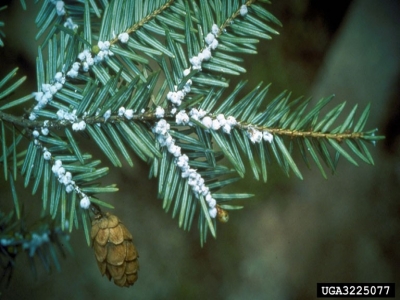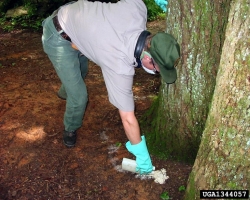Hemlock Woolly Adelgid
Introduction

Native to Asia, the hemlock woolly adelgid (Adelges tsugae), or HWA, is a small, aphid-like insect that threatens the health and sustainability of eastern hemlock (Tsuga canadensis) and Carolina hemlock (Tsuga caroliniana) in the Eastern United States. HWA is the single greatest threat to hemlock health and sustainability in the eastern U.S. The potential ecological impacts of this exotic pest are comparable to that of Dutch elm disease and chestnut blight. HWA was first reported in the U.S. in 1951 near Richmond, Virginia, and has since spread to 21 states, from Maine to Alabama.
The hemlock woolly adelgid is tiny, less than 1/16-inch long, and varies from dark reddish-brown to purplish-black in color. As it matures, it produces a covering of wool-like wax filaments to protect itself and its eggs from natural enemies and prevent them from drying out. This “wool”, which is its ovisac, is most visible when the adelgid is mature and laying eggs. Ovisacs can be readily observed from late fall to early summer on the underside of the outermost branch tips of hemlock trees. The “wool” has also been described as looking like tiny cotton balls.
HWA feed on the nutrient-rich sap of hemlocks through their long straw-like mouthparts. High levels of HWA disrupt the movement of nutrients within the tree, causing needles to change from deep green to a grayish green and then fall off. Even from a distance, a visual sign of more advanced HWA infestation is discoloration of foliage and thinning in the crown of the tree. However, since other hemlock pests can cause some of these symptoms as well, a positive identification for HWA on the foliage is needed. Once established on a tree, it quickly populates all needles of the tree causing mortality within 3 to 10 years of infestations (4 to 10 years in the insect’s northern range, 3 to 6 years in its southern range).
Current Situation
Since its detection in Tennessee in 2002, HWA has spread to 43 counties in East Tennessee and the Cumberland Plateau. On average, HWA has been spreading from east to west at roughly 15 to 20 miles per year. The main vectors that allow hemlock woolly adelgid to spread rapidly are storm winds and migratory birds, as well as “hitchhiking” on mammals and humans. Infested nursery stock can also transport the insect into new areas. Hemlock is not a highly valued timber species but provides invaluable ecological benefits to the forest such as habitat, stream temperature regulation, and stream bank stability. Loss of these values will not only disrupt the delicate natural systems in the forest but also affect aesthetic and recreational benefits.
HWA County Infestation Map

Annual Survey
Due to the near microscopic size of the HWA crawlers (mobile instar phase) and its ease of transportability via birds, mammals, and weather, HWA traps are not effective tools to monitor infestation movement across the state. Traps are, however, used in research settings to detect presence and rate of spread. For detecting new infestations or assessing hemlock health, visual inspection of hemlock trees is the best survey method. Several agencies have established annual survey locations where presence of infestation, health of hemlock trees, and other pertinent data are recorded.

There are several management options available to protect hemlocks from HWA infestation or treat hemlocks after an infestation has been discovered.
Cultural: move bird feeders away from hemlocks, remove isolated infested hemlock trees from your woodlot, do not move hemlock material from an area of infestation to areas that are not infested.
Biological: Natural predators (beetles) that feed on HWA are being released at select sites in Tennessee. Research is still ongoing to develop efficient biological controls that may be released on a larger scale to effectively control HWA populations. Some fungal pathogens that may be effective at killing HWA are also being evaluated as potential biological control options.
Chemical: Several different types of chemical treatments are available. The most common chemical application methods are soil injection and soil drench. Imidacloprid and dinotefuran are the most effective chemical types. Research has proven that chemical treatments can last typically up to 5 years before a second treatment is needed. Please consult the TDF or your local forestry or tree care professional for more information on chemical management options for HWA.
Insecticidal soaps and horticultural oils: These can be sprayed on hemlocks when the objective is immediate control of insects. If complete coverage is achieved, these agents act by smothering all invertebrates on the tree at the time of treatment. There is no residual effect, so HWA could re-infest the tree immediately. With this method, there is an increased risk of applicator contamination and increased concern with drift, since the product is sprayed on the foliage. This treatment method is appropriate for smaller, more accessible trees that could be treated frequently. It would not be appropriate for treating large or inaccessible trees.
What can you do?
The best thing you can do is to learn to recognize the signs and symptoms of infected hemlocks. Do not move infested hemlock products or materials into areas where no known infestation has been documented. If deciding to treat your hemlock, it is also important to understand the options available and work with your local TDF forester or other forestry professional to determine the most effective management plan.
The Tennessee Hemlock Conservation Partnership, which encompasses staff from the Tennessee Wildlife Resources Agency, Tennessee Department of Environment and Conservation, Tennessee Division of Forestry, National Park Service, The Nature Conservancy, US Forest Service, University of Tennessee, as well as concerned individuals, have identified Hemlock Conservation Areas (HCAs) on public lands where treatments have been conducted to conserve hemlocks.
